Trent Alexander-Arnold is one of the finest Liverpool academy products in recent years, and we already can compare his success to the likes of Michael Owen, Steve McManaman, Jamie Carragher, and many others, who also made their way through the ranks of Liverpool academy.
However, Trent didn’t have a proper back-up last season and seemingly this season as well, and many Liverpool fans were worried about the potential consequences of losing him because of injury. Especially this season, after a great start it looked like if Trent was out, then the big part of Liverpool’s creative force would be eliminated.
Fortunately for them, it didn’t happen and Liverpool are marching the league with 22 point gap (at the time of writing), the biggest in competition history.
Even more than that, this season gave us another promising Liverpool youngster for the right-back spot – Neco Williams, the 18-year-old Welsh full-back, whom Ryan Giggs is likely to approach for the national team call-up this March. His amazing displays in both English cups showed that Jürgen Klopp probably doesn’t have to worry about a back-up right-back this summer.
Before Neco was seen in the public eye, Joe Gomez and James Milner were the candidates for that position, now the Welshman can cement that spot for the next season. Having begun to train with the first team at Melwood, Williams himself says that he learns as much as he can from his forerunner, Alexander-Arnold.
In this scout report, we will look at Neco Williams’ best qualities and compare them to Trent’s, to understand if he is ready to step into the first team and compete with TAA, what future role can he play in this Liverpool squad, and also will dive into some areas where he needs to improve.
Statistical overview
Neco Williams has been putting up solid numbers this season. Despite the statistics being available only for both English cups and Champions League U19 matches (plus some U19 international games), from these games, we still can draw some conclusions about his overall performance.
Let’s begin with his defensive stats. Williams makes 5.78 interceptions per game, which is very important for a full-back, as he has to prevent through balls behind the backline, and this also tells you that he understands the game on a decent level already. Along with that, Williams is making 8.34 recoveries per game, and 31.3% of those take place in the opposition half. Considering his headers and aerial duels, he has them on average around three times in every game, winning 54.5% of them, which is a good number. Sadly, there is little data on tackles and other defensive statistics, but, hopefully, the stats listed above gave you the sense of Williams’ defensive output. As we will see in the following section, Williams is a good defender, which is important for Klopp and any other manager, even though in Jürgen‘s football the full-backs are not tasked with many defensive responsibilities.
Moving on to his attacking statistics, Williams makes 5.45 dribbles per game with 61.2% of successful actions. In terms of his passing, he hits on average 8.12 long balls with 43.8% accuracy and also he makes 4.95 crosses and 31.5% of them actually lead to a shot. These are really good numbers for a full-back with great attacking involvement, and a good completion percentage of all those actions on the pitch shows that he has the ability to produce scoring opportunity on a continuous basis, switch play, always be a threat from the wing and so on.
If we look at his xG and xA metrics, his combined expected goals and assists (xG+xA) equal 0.24 per game. Of course, it is important to take into account that he mostly played in Premier League 2 (U21) and in U23 competitions, but he is only 19 and can improve to perform like this on a higher level, and matches with Arsenal and Everton in Carabao and FA cups show that.
Next, we will look at his positioning during the match. First of all, this is a heatmap of Alexander-Arnold for this season.
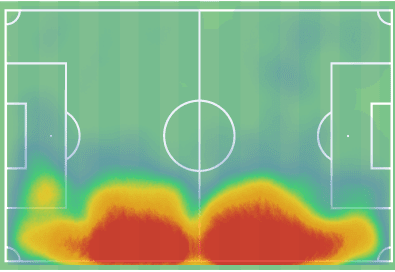
Trent occupies almost all the right side of the pitch, and in the opponent’s half too, as many teams that faced Liverpool this season are using medium/low block and Trent positions himself closer to the final third during the build-up.
In comparison, this is Neco’s heatmap this season:
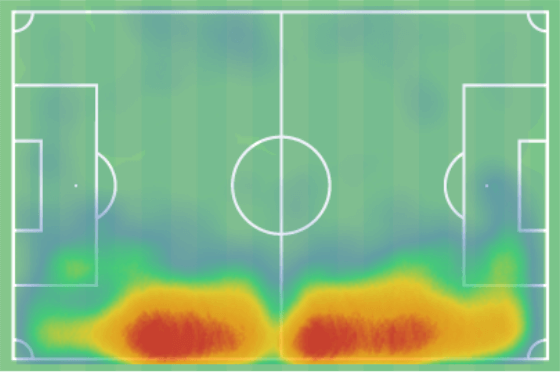
You can tell the obvious similarity in the positioning of these two players. Even though Williams doesn’t spend as much time on the ball as Trent does, his positioning is pretty identical and he covers the same areas on the pitch.
Just like Trent, he is a very attacking full-back, and having those stats proves that he has a similar playing style and also has all the attributes for further development.
Passing
The keynote of this scout report/tactical analysis will be around Williams’ comparison to Alexander-Arnold. Not only because he has the skill set for that and Liverpool’s tactics and current style of football demands such qualities as Trent has from any full-back, but because Neco already showed his class and his ability in some big games for the Liverpool first team.
However, in this section, we will dive into his passing patterns, and the main point I’ve observed from watching these two play is that Neco is not taking as many risks as his 21-year-old teammate does.
He opts to pass the ball to the nearest central defender or a central midfielder much more, especially if he is receiving the ball in his own half. Trent is playing in the dominating side that is arguably the best football side in the world at the moment, and he is one of the most creative players, and that has a big influence.
I believe that will most definitely change when Williams finally makes his way to the first team on a continuous basis, and with time we surely will be able to see Williams play in a more creative manner. Currently, Williams’ passing approach is a little more conservative than that of TAA.
Considering his passing play at the beginning of the attack, during the build-up play, Williams tends to play to one of his nearest teammates and keep the ball for his team. It helps to turn the attack in the other direction and to keep possession. However, that doesn’t mean that Williams doesn’t play dangerous passes to help his team break the opponent’s press.
On the contrary, he can play forward passes and help his team move the ball forward, like in the image below. There to pick up the ball on the right flank, he sees one of the attackers opening himself up and freeing from the defender, and makes an accurate pass to him.
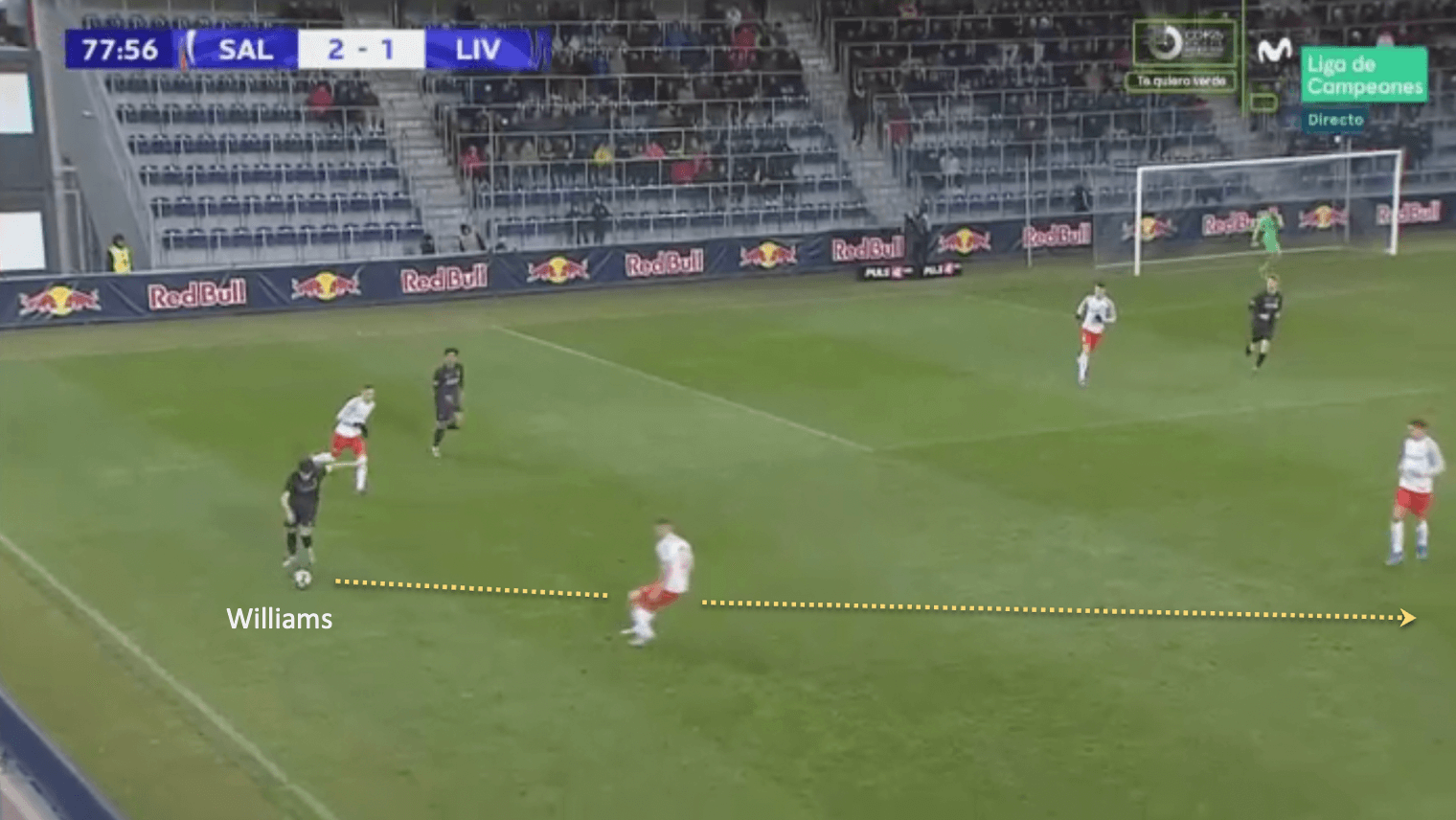
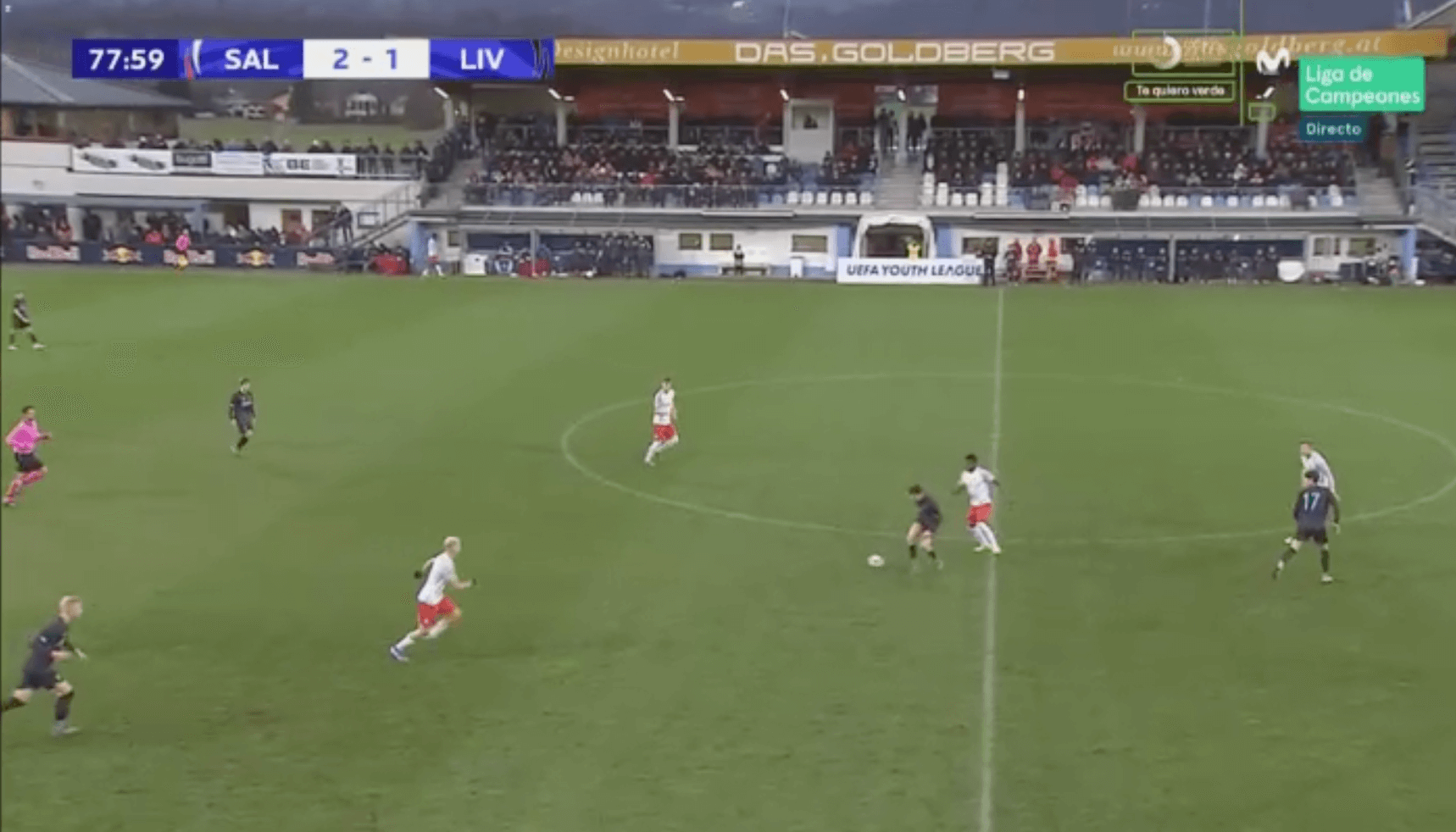
In terms of long passing, Williams excels here as well. As we saw in the statistical section, he makes around four long passes per game. Most of them are vertically-oriented balls behind the defence or in the penalty area, it is approximately 74% out of all his long passes. He can switch the play too, making the passes to the other full-back or winger, even though they do not happen as often.
In the last paragraph of this section let’s look at the passing map of some of his matches. This image helps to highlight the main patterns of his passing play (the blue arrows mean completed passes, the grey ones represent unsuccessful ones). As I wrote in the beginning, the majority of his passes are short/middle passes to the centre or backwards. Also, you can see a couple of long passes to the other side of the pitch. However, the main takeaway is his forward vertical passes to the final third or the penalty area.
He does them a lot and a handful of them are unsuccessful. My main impression is that even though he plays more conservative passes than Alexander-Arnold, he manages to produce a lot of aggressive passes. If he plays in the first team, that number will only increase and that shows that his playing style is a lot like TAA, and it is great both for the player and for Jürgen Klopp.
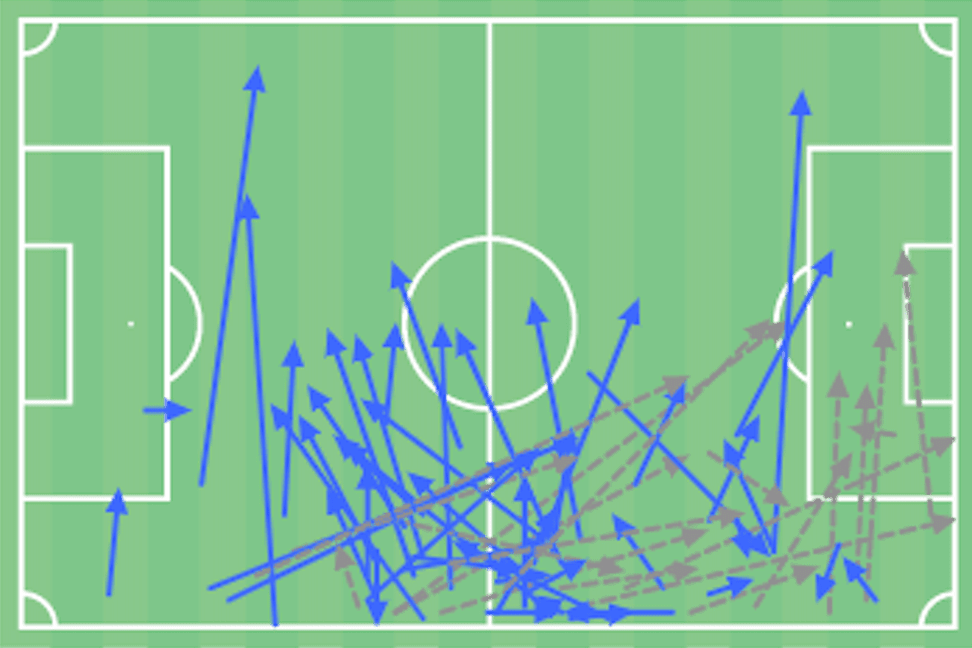
Overall, with some subtle differences, Williams can fill in Trent’s shoes if necessary even now, as he plays a lot like him passing-wise. With Liverpool full-backs being the main force of the creative play, this is a huge benefit for Neco, because he can continue to evolve under the same circumstances, principles and patterns of play. He needs to hone his skills and if he does that, he will thrive at Liverpool for sure.
Crossing
Alexander-Arnold’s famous crossing ability demands at least fit crossing techniques from the potential contender, and Williams possesses that. Many of his crosses made a huge difference for Liverpool advancing to the Round of 16 in the FA Cup and to the quarter-finals of the Carabao Cup. His assist against Arsenal in the extra-time, his two crosses against Shrewsbury that lead to two own goals, one of which was the match-winner. All of this happened only in a couple of cup games, which tells you how productive and involved he is in the attacking department.
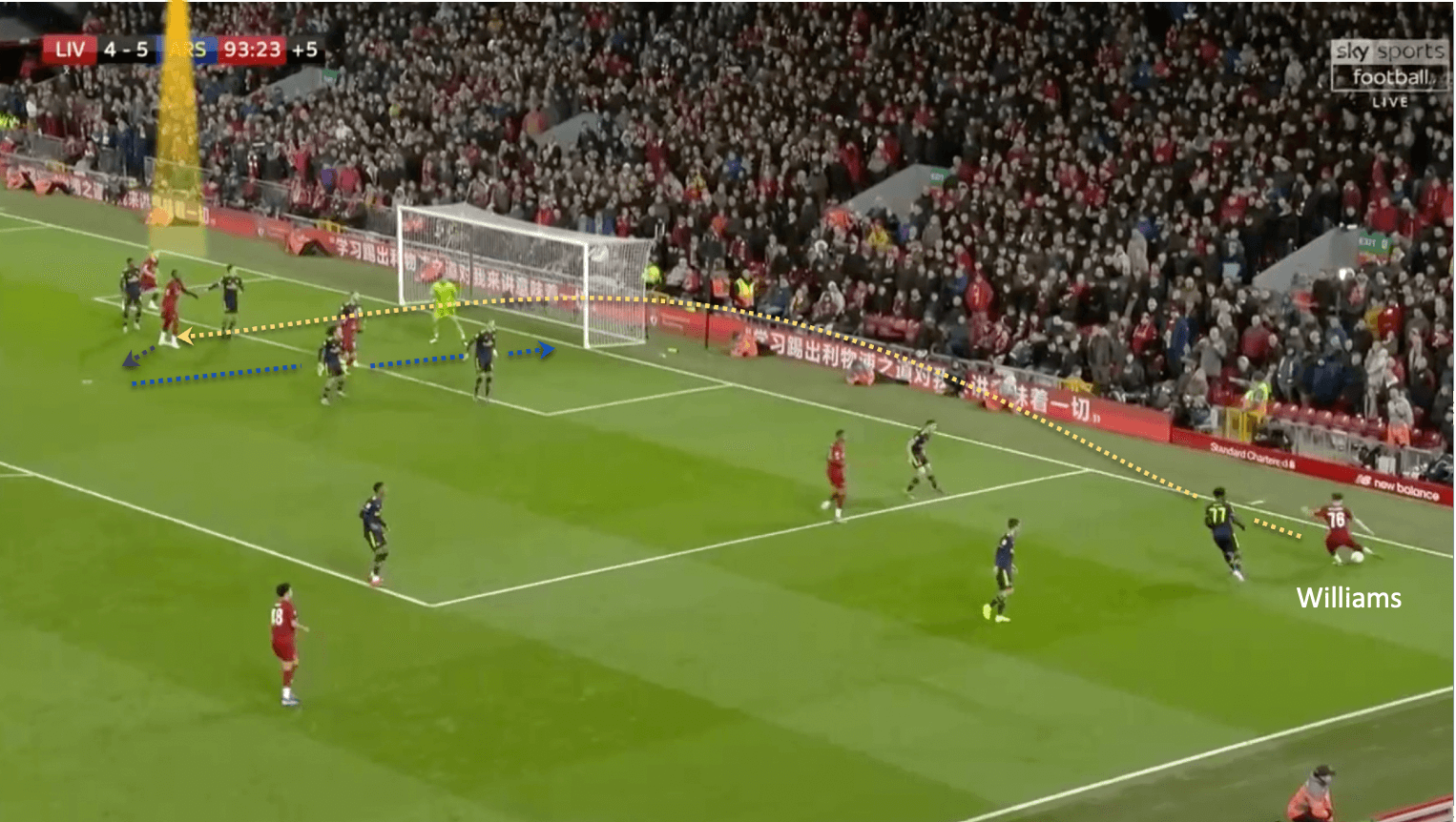
Williams can perform all kinds of crosses: low-driven and over the defence. Below you can see the area from where he puts his crosses in.
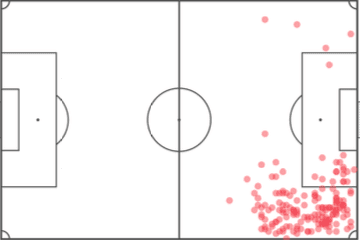
Nonetheless, despite all the contributions he already made for the first team this season, he has to improve his crossing. He is a good crosser of the ball, and many people when they saw him play immediately started comparing him to Trent. Even though all the praise and comparison are well-deserved, Williams still has to improve in terms of his crossing.
Crossing is unsuccessful more often than not, but when everything works out, the attacking team ends up with a goal. But, even considering that, I believe that Neco hits too many crosses wide. The majority of the crosses are either overhit and the ball goes out of play or they are intercepted by the opposition because they were on a too low level.
For example, in the image below you can see that Williams is about to cross, and he has at least three players in the box to aim for. Either a pass to Harvey Elliot, who is right around the edge of the penalty area, or to cross to three players who are running toward the six-yard box. Williams tries to make the second variant happen, but fails, hitting the ball so it ends up on the roof of the goal, above the keeper.
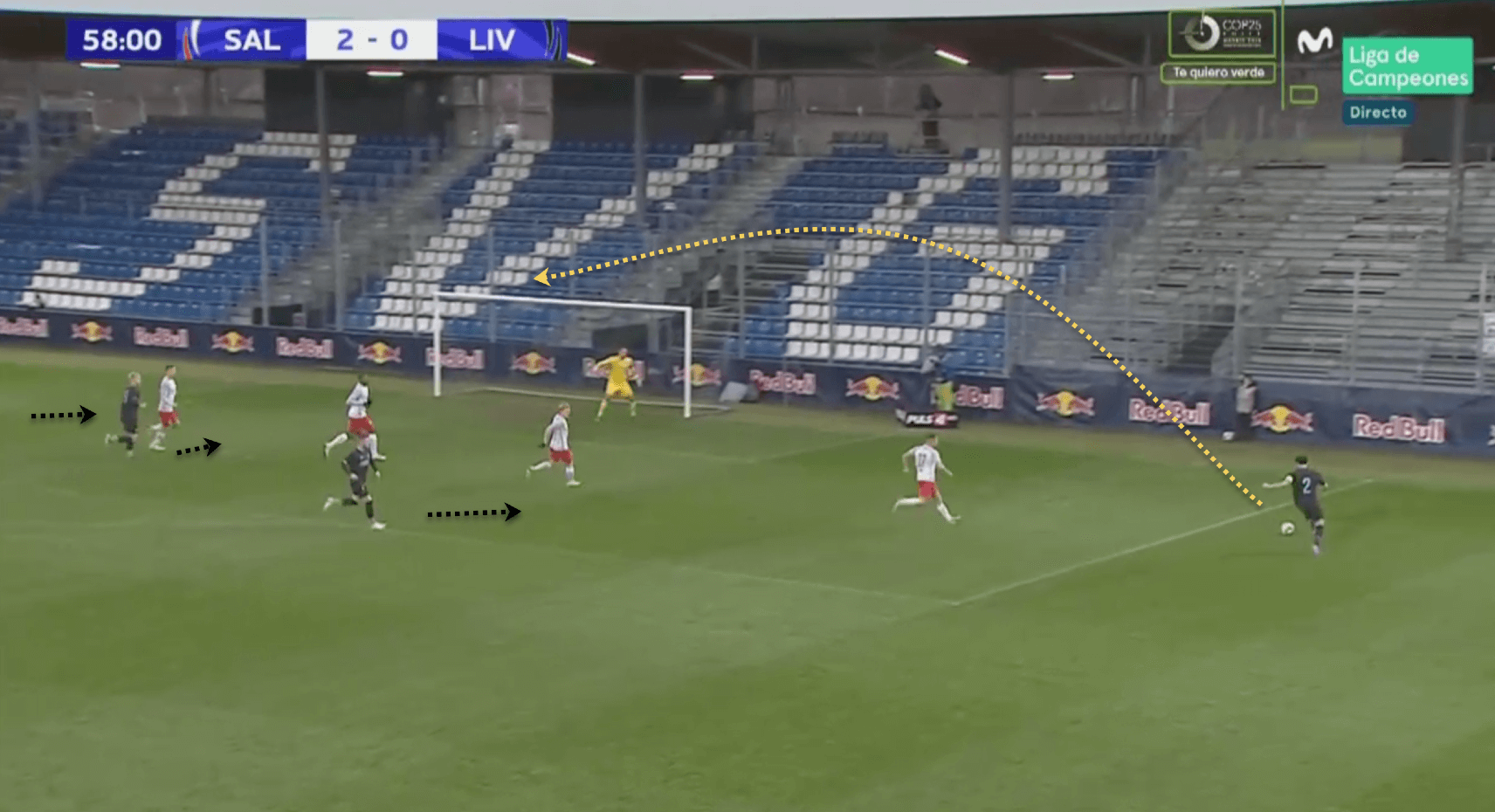
This is one of the things that Williams has to work on to reach Alexander-Arnold’s levels, but he is still very young and has a lot of time to improve in this aspect of his play. He has already shown his abilities previously this season, and if he continues to improve, he will be a great weapon to have down that right flank.
Defending
I am going to start this section of this analysis by saying that Williams is very good at defending, especially for a right-back. He is great at many things that are important for any defender: reading the game, winning aerial duels, right positioning, tackling and so on.
As we discussed earlier, his aerial duels win percentage is slightly above 50%, but in-game it seems that he is winning much more. As full-backs at Liverpool usually tend to push up during the attacks, or even if they are defending, opponents oftentimes try to target the area behind the full-backs with long-balls.
For example, in the game against Arsenal, there were episodes when Saka, who was playing left-winger in that game, was running in behind Williams, and Arsenal defenders and midfielders tried to exploit that space behind Liverpool’s defensive line. However, for the most part, it didn’t work out for them as Williams was controlling the air and not letting Saka get behind him.
Usually, when the ball is in the air and his opponent is staying still, Williams tends to get in front of him and prevent any danger by clearing the ball. He is 6’0” feet tall, and that helps him tremendously, it is very hard to beat him in the air.
In terms of interceptions and reading the game, he is good at that too. He sometimes uses a similar strategy as with aerial balls and gets in front of the attacker to intercept the ball. He is checking the positioning of the opponents behind him and thus he can cut the passing lanes. In the image below, Chambers is trying to make a through ball to Willock, but Williams sees that run, intercepts and gets the ball.
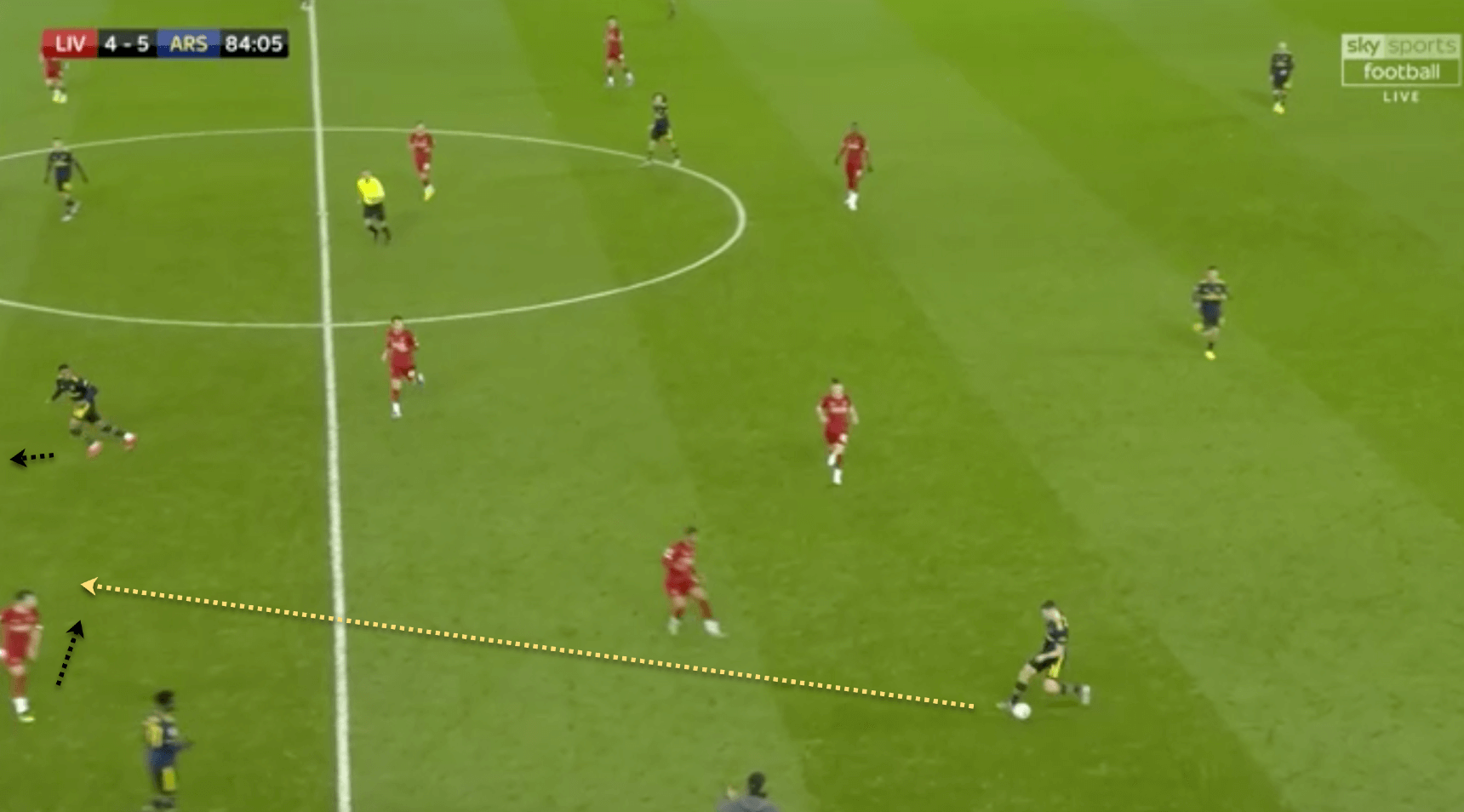
He clears most of the through and long balls that go into his area, so it is always hard to break Liverpool from his flank. Below you can see the map showing the pitch distribution of his interceptions, and they are happening across the right side of the pitch. His reading of the game, height, speed and quick decision-making help him defensively, especially with interceptions.
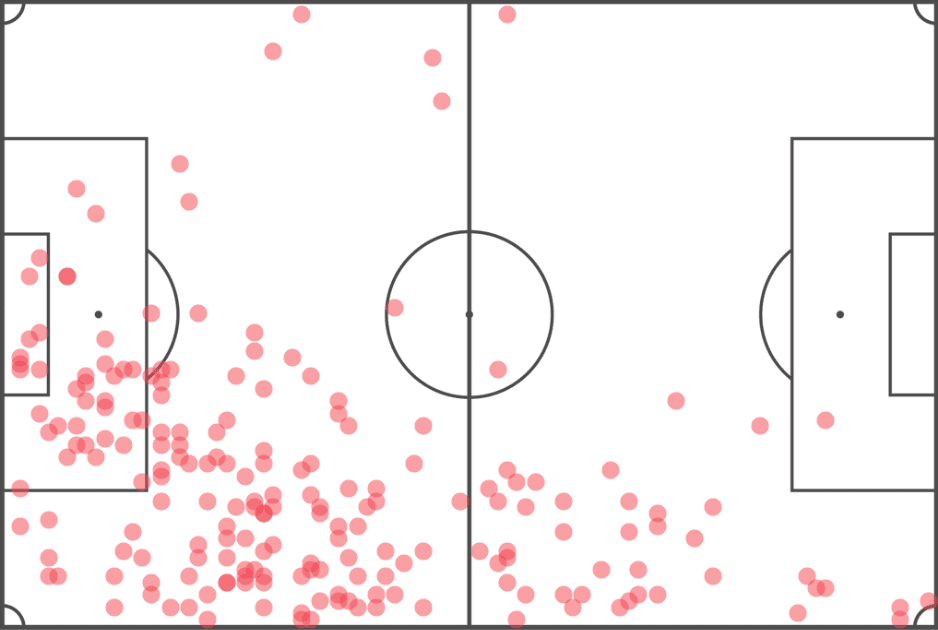
When he has to follow his opponent or tackle them, Williams shows himself as a very tenacious player. He usually runs after his opponent until he loses the ball himself or Williams has to tackle him. In the image below an Arsenal player is receiving the ball on the right flank and he puts his back against Williams to protect the ball. Williams puts pressure on him and eventually tackles him.
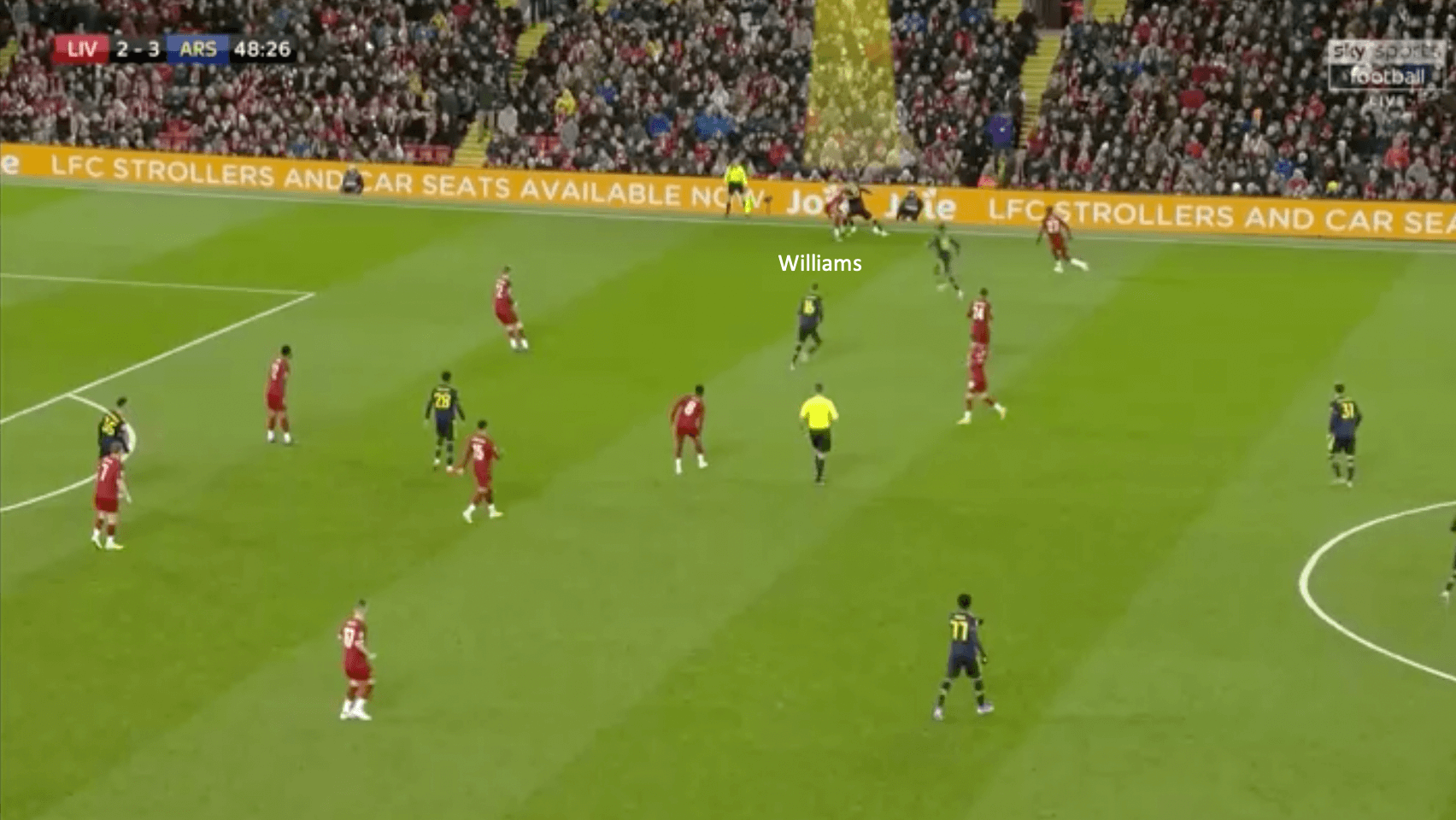
He is good at every component of the defensive play and I believe that he is level with Trent in terms of defending. He is taller, has nearly the same amount of pace, great with tackles and interceptions, excellent at aerial duels. From a defensive standpoint, he is a great player, but of course he can improve even more in the future.
Conclusion
The future of Neco Williams at Liverpool seems bright, but it will be very interesting to see how everything will play out for him. Being in the Liverpool system since he was a six-year-old, making it through the ranks of the Liverpool academy and already conquering the hearts of Liverpool supporters – the circumstances can hardly be any better.
If Williams follows Trent’s footsteps in terms of progress, accommodating these two players on the pitch will not be an easy task for Jürgen Klopp to solve. With Nathaniel Clyne most definitely leaving in the summer and Gomez cementing his spot as a first-choice centre-back, the Williams candidacy for the back-up right-back seems the most obvious.
However, Williams has the experience of playing further forward, as a right midfielder or as a winger, so that is another option. As is the potential for Trent’s position switch, moving to the midfield and filling Gerrard’s shoes. Even though Trent is happy where he plays and Williams is currently content with his role, Klopp’s problem of finding the back-up full-back solved itself but caused other questions. How will it play out? Only time will tell.





Comments